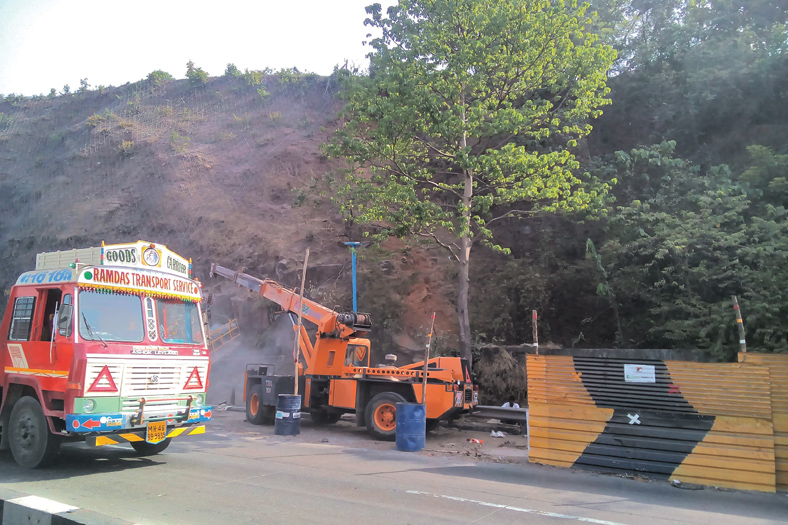9 sustainable building materials that could transform construction

Sustainability is at the heart of today’s building and construction industry. Building with sustainable material not only ensures it will last longer but is also eco-friendly. Here we feature the nine building materials that could help in sustainable construction:
Ultrafine additives
Construction industry is a major contributor to economic development of the country. Infrastructure development through network of roads, bridges, tunnels, rail lines, airports, sea ports facilitates the easy transportation. To satisfy the increasing demand for energy, hydro power, thermal power, nuclear power and solar power generation facilities will be required.
A common and basic factor in all above activities is concrete and concrete structures. Looking at a huge investment required in building up these facilities, sustainability of concrete structures will be a focus point. According to Yatin Joshi, Head – Alccofine, Ambuja Cements Ltd, “Over the period of time concrete technology has undergone a tremendous change. Term ‘High Strength’ is being replaced by ‘High Durability (Sustainability)’. Concrete satisfying all the durability parameters can also be high strength but reverse is not true.”
High performance concrete (HPC) has gained world-wide popularity in the construction industry since 1990. In practice, high performance concrete, are generally characterised by high cement factors and very low W/C ratios. Usage of supplementary materials like fly ash, GGBFS etc. has been in practice since long to achieve durable concrete mixes.
Recent development in achieving sustainable structures (concrete with high durability factor) is Ultrafine slag based additives. Concrete by its nature is a porous material which is single biggest weak point or hindrance towards achieving durability parameters. “Ultrafine particles like Alccofine with average particle size less than 5 microns fills the gap between two cement particles. It improves particle packing density of paste component. With its particle size distribution, chemical composition and reactivity index; it helps refine the pore structure of the cement paste. Such concrete not only becomes more durable but also helps increase the speed of construction,” Joshi said.
Ultrafine additives no doubt hold promising future towards sustainable construction.
Colour membrane
From the last few years, traditional ways of waterproofing such as cementations coating or bituminous membrane application is getting replaced by the acrylic waterproofing coatings like colour membrane.
Colour membrane is considered as ‘green’ and sustainable in terms of solar reflective to reduce the energy use. It can be used for above and below ground applications. It also has properties like best adhesion to substrate, waterproof, heat reflective, life-cycle cost effective and adhere to different weathering condition. “Brush or spray applied elastomeric membrane such as Choksey’s ‘Color Membrane’ provides sustainable waterproofing solution for different application,” said Nikhil Rangari, Asst. Manager Marketing at Choksey Chemicals.
uPVC doors & windows
With advancement of technology in every field, windows and doors are also manufactured keeping in mind sustainability .With variety of options available in the market consumer needs to be conscious about what will sustain in the long run and at the same time the product is budget friendly.
uPVC stand for unplasticized polyvinyl chloride. uPVC windows and doors last longer and installing these will solve your issue for the next two decades. “Windows made of uPVC structures provide higher performance, are efficient in saving energy and can be sustained for a longer period of timewhich makes it extremely eco-friendly. Another advantage of uPVC is that it acts as a natural insulator which helps to resist heat loss in winter and reduces heat in summer,” said Mario Schmidt, Managing Director, Lingel Windows & Doors Technologies.
He further claims, “With our forest depleting and since India is having only less than 1 per cent of the world`s forest area, it is beneficial to use uPVC doors. Also the energy required to produce uPVC profile is only 25 per cent compare to aluminium profile production. Further to add will be the fact that the air pollution is almost 12 times higher and the water pollution is 9 times higher while fabricating aluminium profiles compare to UPVC profiles.”
uPVC windows are tough to fight nature’s fury of atmospheric corrosion. Weathering erosion and discoloration are likely to ruin a wooden door and make it bloat and fade. uPVC eliminates the probability of water, air and sound leakages with its special sealing gaskets.
Fibreglass wool insulation
Thermal insulation has enormous potential to contribute in sustainable building constructions, said Biswajit Roy, Sr. Manager (Building Solutions – Domestic & International), U.P Twiga Fiberglass Ltd. He adds that the materials like fibreglass wool should be helpful in designing the envelope part of green buildings like wall, façade and roof.
Insulation materials like fibreglass wool is approved and awarded green label by several national and international green councils like IGBC, SGBC and GRIHA. As per compliance to the green assessment criteria, the fibreglass wool insulation is free from halogen agents, ODPs, least VOCs, free from heavy metals etc. From several studies in hot countries like Colombia, Brazil, South Africa and India, it can be inferred that this insulation is highly effective in reducing heat ingression through roof and wall and efficient in saving energy consumption of air conditioner to maintain comfort condition. The bonus is the acoustic or sound insulation properties of fibreglass insulation. It helps to achieve better acoustic privacy by absorbing noise inside the building. It also helps to isolate (for the insulated wall system) noise effectively from outside environment.
Stone wool insulation
Stone wool insulation is a versatile material used to insulate against loss of heat and cold, it gives comfort and result in huge energy saving. By decreasing the need to burn fossil fuels, stone wool also reduces air population. Made of rock, stone wool is naturally fire-resistant and does not emit any toxic fumes in the event of fire. It tolerates temperatures of up to 1000 C and is used as vital fire protection in buildings, technical and industrial installations and for marine applications, to protect lives and valuable assets.
The building industry and businesses need to become aware that investments in sustainable construction deliver immediate environmental and financial returns, such as lower carbon emissions and reduced energy consumption.
“ROCKWOOL stone wool insulation solution is cost effective and energy efficient, protecting the environment and improving the quality of life for millions of people,” claims Vinay Pratap Singh, Business Unit Director, ROXUL ROCKWOOL Technical Insulation India Pvt Ltd.
Concrete additives
To enhance the efficiency of concrete in terms of improved constructability, excellent durability and reduced maintenance and time, advanced concrete additives play a critical role. MC-Bauchemie has introduced Centrilit NC, a pozzolanic concrete additive, for this purpose.
“Centrilit NC helps optimise cement content in concrete mixes and also enhances the durability of concrete significantly,” said Sunny Surlaker, Head Admixtures Division, MC-Bauchemie (India) Pvt Ltd.
Permeability reducing admixtures
Permeability reducing admixtures is a good example of an advanced building material that can and has increased the durability of concrete structures and transformed construction.
One of the most common and deadly mechanisms that deteriorate concrete is water. Water acts as a carrier of harmful chemicals such as chlorides etc. that corrode steel reinforcement. Once the integrity of the concrete is compromised, corrosion can spread quickly and undetected throughout the core of the structure. To safeguard from such problems, globally the industry is shifting towards Permeability Reducing Admixtures (PRAs). PRAs also known as “integral waterproofing” are chemical admixtures that protect concrete from the damaging effects of water and water borne chemicals.
The selection of an appropriate PRA depends on the service conditions, and how water is expected to enter the concrete. A document from The American Concrete Institute (ACI), ACI 212.3R-10 Report on Chemical Admixtures for Concrete, subdivides PRAs into two categories based their performance properties:
• PRAN (Permeability Reducing Admixture for Non-Hydrostatic Conditions) admixtures are intended for applications that are not subject to hydrostatic water pressure and are sometimes called damproofing admixtures. Most PRANs contain water repellent chemicals that shed water and reduce water absorption into the concrete.
• PRAH (Permeability Reducing Admixture for Hydro-static Conditions) are primarily intended for use in concrete that is exposed to water under pressure and are sometimes called waterproofing admixtures. They are able to withstand the high hydrostatic pressure for applications such as basements, tunnels and water containment structures.
ACI has tested various PRAs and found that Kryton’s Krystol Integral Membrane (KIM) had met all the test parameters and was truly a PRAH.
“KIM’s unique system works with water and unhydrated cement particles to form million needle-like crystals that block the pores and self-seals cracks of up to 0.5 mm. KIM is different in that it is one of the only admixtures that does not react with free lime and is safe to use with potable water. Once mixed in to the concrete, KIM along with the concrete can be poured directly over the P.C.C. eliminating the cost of overlaying systems like coatings,” explains Anandita Kakkar, Deputy General Manager, Kryton Buildmat Co Pvt Ltd.
Ground granulated blast furnace slag
Traditionally, Ordinary Portland Cement (OPC) concrete is used for making the civil structures. Portland cement can be replaced by Ground Granulated Blast Furnace Slag (GGBS) is manufactured from blast furnace slag which is a non-metallic and non-hazardous by-product of the iron industry.
High volumes of GGBS (more than 50 per cent) can be used as substituting material with good strengths at low water binder ratios and the concretes produced using these mineral admixtures are more dense and durable in the long term.
According to Lopamudra Sengupta, VP – Technical, JSW Cement, “GGBS can also be combined separately with OPC in site batching plant or in ready mix plants to make concrete. While using GGBS in concrete the percentage of replacement of clinker is much greater w.r.t flyash based concrete or PPC concrete (with fly ash, up to 35 per cent maximum replacement possible). With slag replacement levels are as high as 70 per cent.”
Solar roof tiles
On 28th October 2016, Tesla unveiled its new solar roof tiles that eliminate the need for traditional panels and a longer-lasting home battery. Tesla’s solar roof tiles also known as the Powerwall is designed to optimally realise the potential of solar power using solar shingles.
Cookie Consent
We use cookies to personalize your experience. By continuing to visit this website you agree to our Terms & Conditions, Privacy Policy and Cookie Policy.









